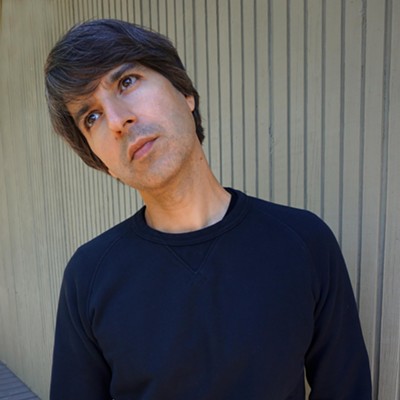In his effort to "recontextualize billboards by sort of making them disappear," Andrew O'Brien installed a photo of the exact view that would be seen from the street if the billboard were not there. Looking at it from a certain angle, you only see the empty frame.
"It's a way to experiment with people's perceptions," says O'Brien. "Sometimes, you notice something through its absence more than its presence. I camouflaged it in a way to make it more visible. ... Some people are a little confused. Some people think it's neat. It's a lot of fun, actually."
O'Brien is interested in the "paradoxical nature of the contemporary landscape." He studies and photographs locations where there is human activity in the wilderness and, in contrast, wilderness areas within the city limits.
"In the wilderness, I choose to photograph areas that show an intense human presence. Recently, as an intern at the Bureau of Land Management, it takes me to these areas. I work in the Ironwood Forest National Monument, about 20 to 30 miles outside Tucson.
"It has this dual presence--a wilderness preserve and an area that receives lots of recreation, has a mining presence, ranching, illegal (migrants). ... They all come together in a seemingly blank space."
In a subsequent e-mail, O'Brien reflected on some startling finds at Ironwood. "I think the most surprising things that I have come across are what we call 'lay-up sites.' These are hidden encampments created by immigrants as they travel through the desert. The most elaborate one I've encountered was hidden in a deep wash along a foot trail. It had makeshift tents and shelters built into the banks of the wash. It had become a very well-established temporary home for the immigrants ... created completely from items that (they) brought with them along the trail."
One of O'Brien's photographs entitled "IFNM BackPack Grid" is an image of 80 backpacks left in the desert by migrants traveling north. They are lined up perfectly, with eight columns and 10 rows. O'Brien says he photographed the backpacks one by one in a day's work. He then digitally grouped them together in one image.
Another unexpected find O'Brien has photographed is a practice called vertical mulching. He explains this in an e-mail: "It is a form of landscape rehabilitation done to (lessen the visual impact of) illegally created roads. In the practice, large dead tree limbs are 'planted' upright in the soil to hide the illegal road in an effort to discourage future use. The result is a bit surreal as the new 'vegetation' is totally dead to begin with, and it looks rather bizarre."
O'Brien has also photographed bizarre pockets of wilderness within city limits. Looking at his photographs, you might think these desolate shots of overgrown fields, mounds of dirt, gravel and bushy vegetation are in some remote part of the country. But they are right here in Tucson.
"Tucson has a large number of these weird lots. They are that way for a variety of reasons. Sometimes, they are left undeveloped, abandoned or waiting for development. They are overgrown and overlooked. I like to think of them as areas more foreign to people than what they traditionally think of as wilderness. I show these areas in a different context."
While his view of urban and wilderness spaces might be untraditional, O'Brien, 25, has participated in several contemporary shows in Tucson. His works have been shown at several exhibitions at Dinnerware Contemporary Arts and also at a group invitational at the Hotel Congress Gallery. He received a Bachelor of Fine Arts from Savannah College of Art and Design and is currently applying to graduate schools.
O'Brien says he enjoys photography, because it can be used as a tool to explain conceptual ideas. With his exploration of everyday surroundings, he looks for "new ways to interpret and understand spaces created by modern infrastructure." By viewing his photographs and looking at their surroundings, he hopes people will experience new ways of viewing the environment around them.
Middle Ground, photographs by Andrew O'Brien, opens with a reception from 7 to 10 p.m., Saturday, Jan. 6, at Shane House Gallery, 218 S. Fourth Ave. The exhibit continues through Wednesday, Jan. 31. Gallery hours are noon to 3 p.m., Saturdays, and by appointment. For more information, visit aobimaging.blogspot.com.







